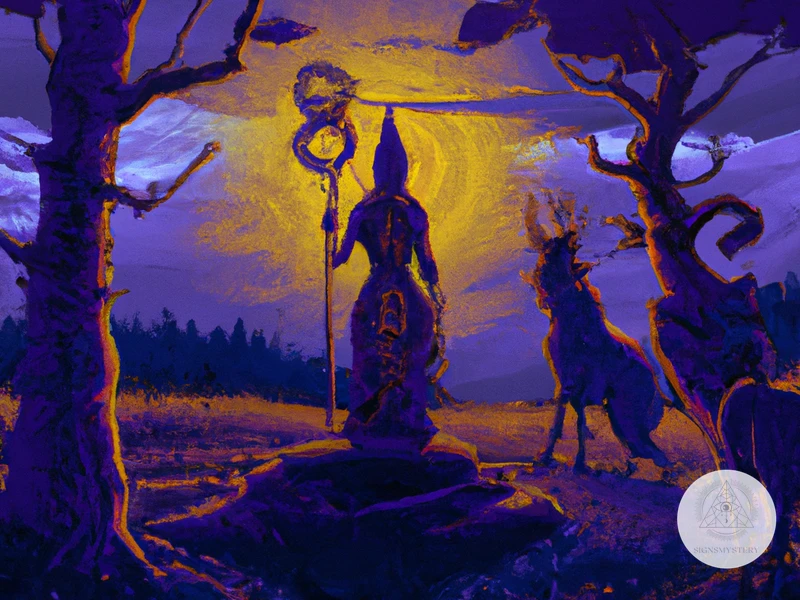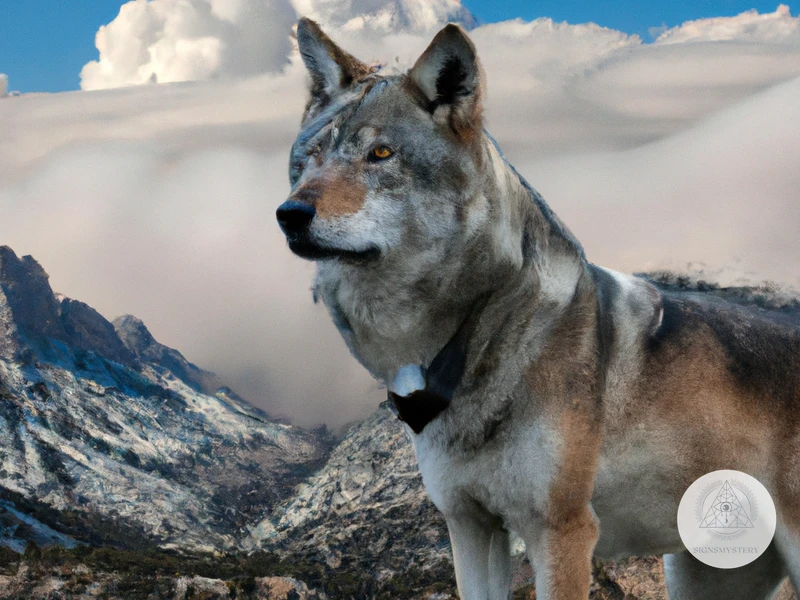Throughout human history, people have looked to the natural world for guidance and inspiration. One way that many cultures have done this is through shamanic traditions, which involve connecting with the spiritual realm and seeking wisdom from animal allies known as spirit animals. These animals are believed to possess special qualities and characteristics that the shaman or practitioner can learn from and emulate. In this article, we will explore the history of spirit animals in shamanic traditions. We will delve into the origins of shamanism, the role of spirit animals, and techniques for discovering your own spirit animal. By the end of this article, you will gain a deeper understanding of this ancient practice and be able to connect with your own spirit animal.
What is Shamanism?

Shamanism is an ancient spiritual practice that has been around for thousands of years and is still practiced by indigenous communities around the world. At its core, shamanism is about connecting with the spirit world in order to bring healing and balance to the physical world. Shamans use a variety of techniques, such as trance-like states and ritual ceremonies, to communicate with spirits and ancestors and to gain insight into the causes of physical and emotional illnesses. The practice of shamanism varies across cultures, but the central belief in the interconnectivity of all things and the power of the spirit world remains constant. For a deeper understanding of shamanism, it is important to explore its origins, core beliefs, and historical use.
Origins of Shamanism
The exact origins of Shamanism are uncertain, but it is believed to have originated in Siberia about 10,000 years ago. The word “shaman” comes from the Tungus tribe in Siberia and means a “‘healer who moves between worlds.” Shamanism spread from Siberia to other parts of the world like Mongolia, China, Korea, and eventually the Americas. Shamanism was not a religion, but rather a practice of healing and communicating with the spirits.
Shamans were known to use various techniques, such as drumming, dancing, and chanting, to alter their state of consciousness and connect with the spirit world. Once connected, shamans would communicate with spirits to receive guidance and healing for the individual or community they were serving.
Scholars who have studied the origins of Shamanism believe that it emerged from the animistic beliefs of early human societies. Animism is the belief that all things are alive and have spirits: the trees, rocks, animals, and even the elements like the wind and water. Animism to Shamanism was a natural transition, as it allowed shamans to communicate with the spirits to provide healing, guidance, and protection to their community.
Shamanism played an essential role in early societies, providing a sense of community and holding the power to heal that was often considered supernatural. Today, Shamanism has experienced a revival and is practiced worldwide, with individuals seeking ancestral connection and personal healing and growth.
Core Beliefs of Shamanism
In shamanism, there are several core beliefs that are associated with this practice. One of the most central beliefs is the idea that everything in the universe is connected, including humans, animals, plants, and even inanimate objects like rocks and water. This interconnectedness is believed to be spiritual in nature and manifests itself in a variety of ways in shamanic practices. According to shamanic belief, there is a spiritual world that interacts with the physical world, and the shaman is able to navigate these realms through altered states of consciousness.
Another core belief in shamanism is the idea that everything has a spiritual energy or essence, often referred to as “soul” or “spirit.” This includes not just living things, but also natural objects, such as mountains and rivers, as well as man-made objects, such as tools and structures. Understanding and connecting with the spiritual essence of objects is fundamental to shamanic practices.
Shamanic belief also includes a focus on healing, both for individuals and communities. Shamans believe that sickness and disease are caused by a spiritual imbalance, and that by restoring balance and harmony to the individual or community, healing can occur. This often involves rituals and ceremonies that are designed to cleanse the body and spirit, and reconnect the individual with their spiritual essence.
Finally, shamans often believe in the existence of spirit guides and helpers, who assist the shaman in their spiritual practices. These spirit guides are believed to be entities from the spiritual realm, who provide guidance and support to the shaman as they navigate the spiritual world. In some cases, these spirit guides may take the form of animals, who serve as the shaman’s connection to nature and the natural world.
The core beliefs of shamanism are centered around the idea of spiritual interconnectedness, the importance of spiritual energy and essence, the focus on healing, and the existence of spirit guides and helpers. These beliefs have been central to shamanic practices for centuries, and continue to be a guiding force for shamans and practitioners around the world.
The Role of Spirit Animals in Shamanic Traditions
Spirit animals play a vital role in shamanic traditions, representing a connection to the spiritual realms and guiding individuals on their journeys. The concept of spirit animals is based on the belief that every living thing has a spirit, and that these spirits can provide insight and wisdom when called upon. Identifying one’s spirit animal is an important part of shamanic practice, as it helps individuals connect more deeply with the natural world around them. The significance of spirit animals varies across different cultures, but they are generally seen as sacred and powerful guides. Understanding the role of spirit animals in shamanic traditions is essential for anyone seeking to deepen their spiritual practice and connect with the spiritual world.
Meaning and Importance of Spirit Animals
Spirit animals are considered to be an integral part of shamanic traditions. They are viewed as spiritual guides or protectors that help individuals navigate through their inner-world or the spirit realm. In shamanism, each spirit animal has its own unique symbolism, and its ‘meaning’ can vary depending on the individual’s cultural background or personal experience. One of the main significances of spirit animals is the guide they provide in a person’s journey to self-discovery, self-awareness, and healing.
The importance of spirit animals lies in their ability to provide direction, wisdom or insight when an individual requires guidance, as well as to offer a sense of comfort and support in difficult times. A spirit animal can also reflect one’s personality traits, strengths, and weaknesses, helping them make better decisions, understand themselves and the world around them. For example, the wolf spirit animal is believed to symbolize loyalty, intuition, and communication. Meanwhile, the eagle spirit animal is associated with freedom, vision, and spiritual awareness.
Each person may have different spirit animals, and some may even change throughout their lifetime, depending on their spiritual evolution and life circumstances. In shamanic traditions, the importance of spirit animals can also vary depending on the cultural context or specific rituals. For instance, in certain traditions, eagle feathers are used to connect with the spirit of the eagle and bring forth its qualities.
The spiritual significance of spirit animals has been recognized by various cultures throughout history. In some cultures, certain animals were worshipped, and their symbolism considered sacred. For example, the lion is known as a symbol of power and authority in ancient Egypt, while the bear is revered as a sacred animal in Native American traditions.
Spirit animals play a crucial role in shamanism and are highly valued for their meaning and significance. They offer guidance, comfort, and wisdom and can assist individuals in their personal growth and self-awareness. The importance of connecting with one’s spirit animal cannot be overstated and is an essential aspect of shamanic practice.
How Spirit Animals are Identified
Identifying one’s spirit animal is a crucial part of shamanic tradition. This process involves deep introspection and an open mind to receive messages from the spiritual realm. There are several techniques that shamans use to identify spirit animals. One of the most common methods is through meditation. By quieting the mind and focusing on the intention of connecting with a spirit animal, a shaman can receive visual images or messages that help them identify their spirit animal.
Another technique for identifying a spirit animal is through dreams. Shamans believe that dreams can provide messages from the spiritual realm, and that spirit animals can manifest in dreams to communicate with individuals. In addition to meditation and dreams, spirit animals can also be identified through observing one’s environment. A shaman may focus on animals that appear frequently in their life or that have unique behaviors that resonate with them.
Shamans also believe that spirit animals can be inherited. In some cultures, certain animal totems are passed down through family bloodlines as a way to connect with ancestral spirits. Often, these inherited spirit animals reflect the personality traits or skills of ancestors.
The process of identifying a spirit animal is deeply personal and unique to each individual. Shamans rely on their intuition and spiritual connection to the natural world to help them identify spirit animals. By embracing the messages and guidance of spirit animals, shamans can deepen their connection with the spiritual realm and use this knowledge to guide their healing practices.
An interesting fact is that spirit animals can also be represented by objects or symbols. For example, in Native American traditions, it is believed that each individual has a birth totem that corresponds to the time of year they were born. These birth totems can be represented by different symbols and carry unique spiritual meanings. Additionally, some shamanic cultures use specific artifacts or images to represent their spirit animals during rituals or ceremonies. These objects serve as physical reminders of the spiritual connection between the shaman and their spirit animal.
To learn more about the spiritual significance of shamanic artifacts, click on this link.
Examples of Spirit Animals in Different Cultures
StrongExamples of Spirit Animals in Different Cultures: Spirit animals have been revered and respected in different cultures around the world. In the Celtic tradition, the stag was considered a powerful spirit animal, representing intuition and masculinity. The bear was also viewed as a powerful spirit animal by the Celtic people, symbolizing strength, healing, and introspection.
In Native American cultures, the eagle is a commonly referenced spirit animal, representing strength, courage, and wisdom. The bison is also an important spirit animal in many Native American cultures, recognized for its abundance and its association with the earth.
In many African cultures, the lion is viewed as a powerful spirit animal, symbolizing strength, wisdom, and courage. The elephant is also an important spirit animal in African culture, embodying family, loyalty, and intelligence.
In Hindu traditions, the cow is venerated as a spirit animal, representing gentleness, abundance, and nurturing. The monkey is also a significant spirit animal in Hinduism, representing playfulness, curiosity, and innovation.
Each of these cultures, among many more not mentioned, has unique interpretations and beliefs about spirit animals and their symbolism. However, the overarching idea is that spirit animals serve as spiritual guides and teachers, helping individuals to connect with deeper truths about themselves and the world around them.
If you’re interested in learning more about shamanic traditions, you may find it useful to read about the integration of shamanism and religion in the past, the importance of ancestral connections in shamanism, or the significance of the shamanic vision quest.
The Historical Use of Spirit Animals

Throughout history, the use of spirit animals has been prevalent in many civilizations and cultures. In ancient civilizations such as Egypt and Greece, many gods and goddesses were depicted with animal heads or had certain characteristics of animals. In Native American traditions, spirit animals played a crucial role in guiding individuals on their spiritual journey and were believed to have unique powers and traits that could be passed down to the individual. In contemporary shamanism, the use of spirit animals still holds significant importance and is often used as a tool for healing and self-discovery. The historical use of spirit animals showcases the important role that animals have played in human cultures and the power that we have attributed to them in our spiritual practices.
Spirit Animals in Ancient Civilizations
Spirit animals have played a significant role in the spiritual practices of ancient civilizations. The concept of spirit animals can be traced back to the Paleolithic era, where early humans incorporated animals as part of their belief systems and cave art. As societies evolved and became more complex, the use of spirit animals remained prevalent across various cultures.
One example of spirit animals in ancient civilizations can be seen in ancient Greek mythology. The Greeks used animals to represent their gods and goddesses, with each animal symbolizing specific traits. For instance, the owl represented wisdom, while the lion represented strength and courage.
Similarly, in ancient Egyptian culture, spirit animals were given great prominence, and many gods and goddesses were depicted with animal heads. The Egyptians believed animals possessed spiritual qualities and could serve as intermediary beings between the divine and human realms. They also mummified animals as a way to honor them and ensure their safe passage into the afterlife.
In the Mayan civilization, jaguars were revered as powerful spirit animals that could provide protection and guidance. Mayan shamans would often depict themselves with jaguar features during spiritual practices and rituals.
In ancient Chinese culture, spirit animals are a crucial aspect of Feng Shui practice. Each animal is believed to possess unique and powerful characteristics that can be utilized to promote harmony and positive energy within a living space or environment.
As we can see, the concept of spirit animals has been an integral part of many ancient civilizations and cultures, as it offers a way to connect with the natural world and divine realms. Understanding the symbolic and spiritual significance of animals in these cultures provides us with a deeper insight into their worldviews and beliefs.
Spirit Animals in Native American Traditions
The use of spirit animals is deeply ingrained in Native American traditions. In fact, the sacred relationship between animals and humans is believed to be a fundamental aspect of human life. Native Americans believe that every animal has a unique power that can help individuals in their daily struggles.
Subscribe to Our Newsletter
Sign up to receive the latest news and updates.
Animal Totems
One of the most significant ways in which spirit animals are integrated into Native American traditions is through the concept of animal totems. An animal totem is an animal that is believed to have a special relationship with an individual or a family. This relationship is said to provide spiritual guidance and protection. The process of identifying one’s animal totem involves paying close attention to dreams, visions, and intuition.
The Bear
In Native American traditions, The bear is a symbol of strength, courage, and introspection. The bear is often associated with healing practices and is believed to have significant spiritual power. The bear is also an important animal in many Native American creation stories.
The Wolf
The wolf is another commonly referenced spirit animal in Native American traditions. The wolf is seen as a symbol of loyalty, community, and family. Wolves are known for their strong social bonds and are often invoked during times of family strife.
The Eagle
The eagle is one of the most sacred animals in Native American culture. The eagle is associated with spiritual power, wisdom, and freedom. Eagles are often used as symbols during religious ceremonies and are believed to offer a direct link between the spiritual world and the physical world.
The Buffalo
The buffalo, or the American bison, is an animal that has played a significant role in Native American cultures for centuries. The buffalo is viewed as a symbol of strength, abundance, and unity. Buffalo hunts were once a central aspect of Plains Indian cultures and were performed with great reverence for the animal’s spirit.
Native American traditions teach that all animals have a spiritual significance and can provide guidance and protection for individuals and communities. The use of spirit animals has been an integral part of Native American cultures for centuries and continues to be an important way to connect with nature and the spiritual world.
Spirit Animals in Contemporary Shamanism
have different meanings and they rely on an individual’s personal experience. In modern times, spirit animals have become more symbolic than actually utilized for spiritual and practical purposes. People today often connect with their spirit animals through meditation, imaginative journeys, or shamanic healing sessions. In contemporary shamanism, the focus is on the individual rather than the community, and shamans often use spirit animals to help individuals better understand themselves and their purpose in life.
Contemporary shamanism is often associated with alternative healing techniques that focus on spirituality and mindfulness. It is a therapeutic approach that deals with the patient as a whole, treating not only physical ailments but also emotional, mental and spiritual issues. Shamans in contemporary settings often work with clients to discover their spirit animals using various approaches such as drumming, meditation, and visualization.
Spiritual leaders and healers in modern times draw on traditional shamanic practices to counsel, guide and heal individuals. However, the main difference between contemporary shamanism and the traditional version is the way people use it for self-discovery and improvement. Some people seek to connect with their spirit animals to get answers to spiritual questions, while others may look to the animal world for guidance, strength and inspiration.
Contemporary shamanism is a result of cultural changes and evolution, but it has not lost its basic essence of finding harmony between humans, nature, and the universe. It has moved away from the strict rules and religious aspects of traditional shamanism to become more inclusive, personal, and experiential.
In the next section, we will discuss techniques for discovering your spirit animal and the benefits of connecting with them.
Connecting with Your Spirit Animal
Connecting with your Spirit Animal is a central part of Shamanism. It is believed that these animals act as guides and offer protection and support to those who connect with them. There are several techniques for discovering your spirit animal, including meditation, going on a wilderness retreat, or seeking guidance from a shamanic practitioner. Once you discover your spirit animal, it is important to develop a relationship with it. This may involve offering it offerings or performing rituals in its honor. The benefits of connecting with your spirit animal include a greater sense of self-awareness, a deeper connection to nature, and a feeling of being supported in your daily life. Whether you are a seasoned practitioner or new to shamanism, connecting with your spirit animal can be a powerful experience that can help you on your path.
Techniques for Discovering Your Spirit Animal
There are several techniques that can be used to discover your spirit animal. One of the most common methods is through meditation or journeying. To do this, sit in a quiet space and focus your mind on the intention of connecting with your spirit animal. You may also want to burn incense or light candles to create a peaceful atmosphere. As you begin to feel more relaxed, imagine yourself walking through a forest or jungle. As you explore your surroundings, pay attention to any animals that come across your path. This could be a sign that this animal is your spirit animal. When you find an animal that catches your attention, try to engage with it by asking for its name and purpose in your life.
Another technique that can be used to connect with your spirit animal is to pay attention to any recurring dreams or visions you may have. If you consistently see a particular animal in your dreams or visions, it could be your spirit animal trying to communicate with you.
You can also use divination tools, such as oracle cards or a pendulum, to discover your spirit animal. These tools can help you tap into your intuition and connect with your spiritual guides. Simply ask the question, “What is my spirit animal?” and use the tool to receive an answer.
It’s important to remember that discovering your spirit animal is a process that may take time and patience. Be open to receiving messages and signs from the universe, and trust that your spirit animal will reveal itself to you when the time is right.
If you are interested in learning more about shamanism and the role of spirit animals, check out our article on the role of ancient shamans in society here, or explore the significance of ayahuasca ceremonies in ancient cultures here. You can also learn about the evolution of shamanic healing techniques here, the history of women shamans in historical societies here, or the intersection of shamanism and indigenous politics here.
The Benefits of Connecting with Your Spirit Animal
Connecting with your spirit animal can provide numerous benefits that can help you in your physical, emotional and spiritual life. Here are some of the benefits of connecting with your spirit animal:
| Benefits | Description |
|---|---|
| Personal empowerment | Connecting with your spirit animal can provide you with a sense of empowerment as you gain a deeper understanding of yourself and your place in the world. |
| Guidance and support | Your spirit animal can act as a guide and offer you support as you navigate different life challenges. By connecting with your spirit animal, you can receive insights, guidance, and assistance in your daily life. |
| Healing and transformation | Connecting with your spirit animal can also provide you with healing and transformation. As you work with your spirit animal, you can become more aware of your inner wounds and gain insights into how to heal and transform them. |
| Increased creativity and inspiration | Your spirit animal can act as a source of inspiration and creativity in your life. By connecting with your spirit animal, you can tap into your creative potential and gain new insights and ideas. |
| Greater sense of purpose | Connecting with your spirit animal can also help you gain a greater sense of purpose and direction in your life. By working with your spirit animal, you can gain insights into your life’s purpose and find the path that is aligned with your soul’s journey. |
By connecting with your spirit animal, you can experience a new level of self-awareness and spiritual growth. Whether you are seeking guidance and support, healing and transformation, or increased creativity and inspiration, your spirit animal can provide you with the wisdom and insights you need to navigate life’s challenges and fulfill your highest potential.
Conclusion
In conclusion, the use of spirit animals in shamanism dates back to ancient civilizations and remains an important aspect of contemporary shamanism. Spirit animals serve as guides, helpers, and protectors and are identified through various techniques including meditation, introspection, and dream analysis.
Connecting with one’s spirit animal can bring about numerous benefits such as increased self-awareness, a deeper understanding of one’s place in the world, and a sense of empowerment. It is important to remember that each individual’s relationship with their spirit animal is unique and personal, and cannot be dictated by external forces.
While spirit animals are often associated with Native American traditions, it is important to recognize that they exist in various cultures around the world and can hold different meanings and symbolism. It is important to approach the topic with respect and an open mind.
Overall, the concept of spirit animals adds a unique and mystical dimension to shamanic traditions. It allows individuals to tap into a deeper understanding of themselves and the world around them, and to seek guidance and support from the spirit realm. Through an ongoing exploration and connection with their spirit animal, individuals can continue to deepen their understanding of themselves and the world.
Frequently Asked Questions
What is the significance of spirit animals in shamanic practices?
Spirit animals serve as guides and helpers in shamanic practices, aiding individuals in their spiritual journeys and providing insight and wisdom.
Can a person have more than one spirit animal?
Yes, it is possible for a person to have multiple spirit animals throughout their life, as different animals can come forward to provide guidance in different situations.
How do shamans communicate with spirit animals?
Shamans communicate with spirit animals through various methods, including meditation, dreamwork, and shamanic journeying.
Can spirit animals be chosen consciously?
While it is possible to consciously choose to work with a specific animal, traditional shamanic practices involve allowing the spirit animal to come to the individual through meditation or other spiritual practices.
Do different cultures have different interpretations of spirit animals?
Yes, different cultures have different beliefs and interpretations of spirit animals, which can vary based on geographic region and cultural traditions.
Can spirit animals change throughout a person’s life?
Yes, spirit animals can change throughout a person’s life, based on their personal growth and spiritual journey.
What is the purpose of connecting with one’s spirit animal?
Connecting with one’s spirit animal can provide insight, guidance, and a sense of interconnectedness with the natural world and the spiritual realm.
How can one develop a deeper relationship with their spirit animal?
One can develop a deeper relationship with their spirit animal through regular shamanic practices, such as meditation and journeying, and by honoring their animal through ritual and offerings.
Is it necessary to work with a shaman to connect with one’s spirit animal?
No, it is not necessary to work with a shaman to connect with one’s spirit animal, as individuals can develop their own spiritual practices and connect with their spirit animal in their own way.
Can spirit animals provide insight into one’s personality traits?
Yes, spirit animals can provide insight into one’s personality traits and provide guidance for personal growth and transformation.










